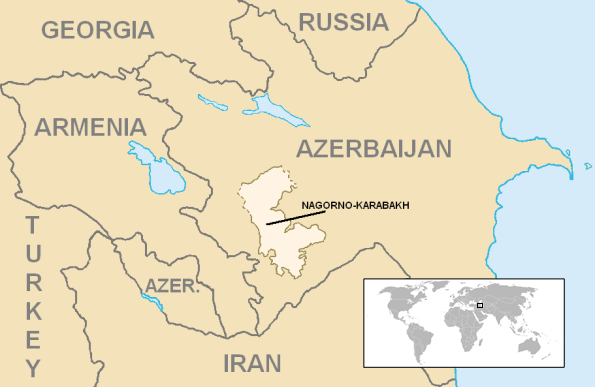
The “frozen conflict” of Nagorno-Karabakh may not melt down anytime soon because of the involvement of multitude of interests.
Two decades of international community administered talks between Armenia and Azerbaijan over Nagorno-Karabakh, a predominantly Armenian enclave inside Azerbaijani territory, have failed to reach a resolution. Meanwhile, Azerbaijan’s petro-dollar aided exponential increase in defence expenditure amid pitched rabble-rousing and frequent sniper skirmishes in the region has led many to fear that the disputed landlocked mountainous enclave in the Greater Caucasus could be one of the most likely sites of Europe’s next war.The sense was reiterated on March 28 by Arayik Haroutiounian, the secessionist enclave’s prime minister, who said in Paris that Azerbaijan and Armenia are unlikely to reach a deal this year and there is a risk of the region sliding towards a war.
But is peace such an imminent casualty in Nagorno-Karabakh, and by extension in the Greater Caucasus?
The short answer is no. While stubborn stances of the warring actors based upon ethnic and historical arguments and applicable competing principles of international law – the right of self-determination and territorial integrity – promise to make the coming years equally difficult for a negotiated agreement, the oft-repeated talk of a fresh war may not match up with the realities of limited abilities of the warring states to win a war outright, and dependence of external actors, notably the United States, Russia and Europe, on continued status-quo, if not negotiated peace, towards serving their economic and geopolitical interests in the region.
Adding their bits to the competitive counterbalancing are Turkey and Iran.
Turkey, which is accused by Armenia of the “Great Crime” (the 1915 massacre of over a million Armenians by Ottoman Turks), shares a “one nation-two states” doctrine with Azerbaijan because of the cultural similarities between the two. Consequently, the Turkish government has been participating in the conflict through military cooperation with the Azerbaijanis and declared a blockade on Armenia in 1993 in support to Azerbaijan. Turkey has been refusing to re-open diplomatic relations and its border with Armenia until the Nagorno-Karabakh conflict is resolved.
Iran, the remaining major regional actor in the dispute, which has economic interests in the region and, like Russia, wants to keep Western countries away from the region, has been a major partner for Armenia and Nagorno-Karabakh – despite being an Islamic state. It has helped the two fight the economic blockade enforced by Azerbaijan and Turkey after the war.
The coming together of multitude of conflicting interests is not a recent phenomenon in the Caucasus. The vantage geographical position of the region has historically allowed both opportunity for and defence against transcontinental (Central Asia-Europe) expansionist designs of the powers that were – like the Ottoman Empire and Russia.
Currently, the region is critical to the United States and NATO’s military interests. For example, the Northern Distribution Network (NDN) played an important role in transporting the United States and NATO supplies out of Afghanistan when in November 2011 Islamabad closed supply routes between Pakistan and Afghanistan following a United States air strike that accidentally killed 24 Pakistani troops.
Also, the region is a critical energy corridor for hydrocarbon resources en route to Europe from the South Caucasus and Central Asia. Three of the four major pipelines that transport Azerbaijani oil and gas to Europe lie close to the front line positions of Armenian and Azerbaijani forces stationed along both the Line-of-Contact between Azerbaijan and the disputed enclave of Nagorno-Karabakh, and the Armenia-Azerbaijan border.
In the event of a fresh war over Nagorno-Karabakh, these pipelines could become early targets for Armenian artillery, hitting Europe’s goal of diversifying its energy supply.
It is this complexity that is not only holding back an all-out war, but also forcing all the concerned players to put their best thinking hat forward to bring about a solution to, what is known as, the “frozen conflict.”
Since 1994, there have been a number of attempts to broker peace by the so-called Minsk Group, a subset of the Organization for Security and Cooperation in Europe (OSCE) chaired by Russia, the United States, and France. But the issue of sequences remains one of the biggest obstacles to the signing of a peace treaty. Azerbaijan wants Armenia to end its occupation first and withdraw its forces before discussing the republic’s final status; Armenia is seeking a resolution first on the status question before pulling out its forces; Nagorno-Karabakh wants its independence officially recognized prior to all other negotiations.
Against the backdrop of the current state of the deadlock, there is a possibility of the following scenarios developing in the coming year:
The dispute presents itself as an ideal case study for the Greater Caucasus region to understand the conflict between ethnic minority groups’ fierce attachment to their socio-historical and geographical identities and modern world’s need for enforcement of legal principles. The conflict in this case is not about resources, but is about identity – something that cannot be divided.
Currently, the talk is more about the “best alternative to a negotiated agreement” (BATNA). For Azerbaijan, it is war, and for Armenia, it is status-quo.
Expect the Armenian position to prevail in the coming year.